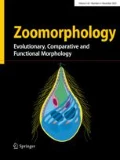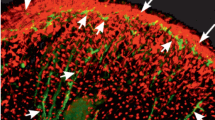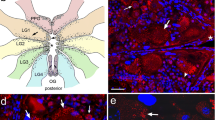Abstract
The study is dedicated to an identification of specific FMRF immunoreactivity in planarian (Girardia tigrina) with special attention to the FMRF-like neuropeptides location near muscle filaments. Using of whole mounts in conjunction with a confocal laser scanning microscopy reveals close spatial relationship of FMRF-immunopositive(-IP) nerves and planarian musculature. Morphological data provide an evidence for FMRF-like peptides participation in the innervations of planarian muscles. The results indicate that the larger part of muscular structures and organs (pharynx, mouth opening, body wall, and tail) of planarian body are deeply supplied by FMRF-IP nerve elements. Such observation of the peptidergic FMRF-IP neurons and its processes in vicinity of the muscle fibers can indicate an important role of the neuropeptides in the regulation of planarian muscle function.



Similar content being viewed by others
References
Baguna J (2012) The planarian neoblast: the rambling history of its origin and some current black boxes. Int J Dev Biol 56:19–37
Cebrià F (2008) Organization of the nervous system in the model planarian Schmidtea mediterranea: an immunocytochemical study. Neurosci Res 61:375–384
Cebrià F (2016) Planarian body-wall muscle: regeneration and function beyond a simple skeletal support. Front Cell Dev Biol 4:8. https://doi.org/10.3389/fcell.2016.00008
Cebrià F, Vispo M, Bueno D, Carranza S, Newmark Ph, Romero R (1996) Myosin heavy chain gene in Dugesia (G.) tigrina: a tool for studying muscle regeneration in planarians. Int J Dev Biol Suppl 1:177S–178S
Cebrià F, Vispo M, Newmark Ph, Bueno D, Romero R (1997) Myocyte differentiation and body wall muscle regeneration in the planarian Girardia tigrina. Dev Genes Evol 207:306–316
Christie AE (2015) In silico characterization of the neuropeptidome of the Western black widow spider Latrodectus hesperus. Gen Comp Endocrinol 210:63–80
Collins JJ, Hou X, Romanova EV, Lambrus BG, Miller CM, Saberi A, Sweedler JV, Newmark PA (2010) Genome-wide analyses reveal a role for peptide hormones in planarian germline development. PLoS Biol 8:e1000509
Davies EL, Lei K, Seidel CW, Kroesen AE, McKinney SA, Guo L, Robb SMC, Ross EJ, Gotting K, Alvarado AS (2017) Embryonic origin of adult stem cells required for tissue homeostasis and regeneration. eLife 6:e21052
Day TA, Maule AG (1999) Parasitic peptides! The structure and function of neuropeptides in parasitic worms. Peptides 20:999–1019
Day TA, Maule AG, Shaw C, Halton DW, Moore S, Bennett JL, Pax RA (1994) Platyhelminth FMRFamide-related peptides (FaRPs) contract Schistosoma mansoni (Trematoda: Digenea) muscle fibers in vitro. Parasitol 109:455–459
Ermakov A, Ermakova O, Skavulyak A, Kreshchenko N, Gudkov S, Maevsky E (2016) The effects of the low temperature argon plasma on stem cells proliferation and regeneration in planarians. Plasma Processes Polym 13:788–801
Fraguas S, Barberan S, Ibarra B, Stöger L, Cebrià F (2012) Regeneration of neuronal cell types in Schmidtea mediterranea: an immunohistochemical and expression study. Int J Dev Biol 56:143–153
Geary TG, Price DA, Bowman JW, Winterrowd CA, Mackenzie CD, Garrison RA, Williams JF, Fridman AR (1992) Two FMRFamide-like peptides from the free-living nematode Panagrellus redivivus. Peptides 13:209–214
Gustafsson MK, Halton DW, Kreshchenko ND, Movsessian SO, Raikova OI, Reuter M, Terenina NB (2002) Neuropeptides in flatworms. Peptides 23:2053–2061
Halton DW, Maule AG, Mair GR, Shaw C (1998) Monogenean neuromusculature: some structural and functional correlates. Int J Parasitol 28:1609–2163
Hori I, Kishida Y (2003) Quantitative changes in nuclear pores and chromatoid bodies induced by neuropeptides during cell differentiation in the planarian Dugesia japonica. J Submicrosc Cytol Pathol 35:439–444
Inoue T, Hoshino H, Yamashita T, Shimoyama S, Agata K (2015) Planarian shows decision-making behavior in response to multiple stimuli by integrative brain function. Zool Lett 1:7. https://doi.org/10.1186/s40851-014-0010-z
Joffe BI, Reuter M (1993) The nervous system of Bothriomolus balticus (Proseriata)—a contribution to the knowledge of the orthogon in the Plathelminthes. Zoomorphology 113:113–127
Johnston RN, Shaw C, Halton DW, Verhaert P, Baguna J (1995a) GYIRFamide: a novel FMRFamide-related peptide (FaRP) from the triclad turbellarian, Dugesia tigrina. Biochem Biophys Res Commun 209:689–697
Johnston RN, Shaw C, Brennan GP, Maule AG, Halton DW (1995b) Localisation, quantitation, and characterisation of neuropeptide F- and FMRFamide-immunoreactive peptides in turbellarians and a monogenean: a comparative study. J Comp Neurol 357:76–84
Johnston RN, Shaw C, Halton DW, Verhaert P, Blair KL, Brennan GP, Price DA, Anderson PA (1996) Isolation, localization, and bioactivity of the FMRFamide- related neuropeptides GYIRFamide and YIRFamide from marine turbellarian Bdelloura candida. J Neurochem 67:814–821
Kotikova EA, Raikova OI, Reuter M, Gustafsson MK (2002) The nervous and muscular systems in the free-living flatworm Castrella truncata (Rhabdocoela): an immunocytochemical and phalloidin fluorescence study. Tissue Cell 34:365–374
Koziol U, Koziol M, Preza M, Costabile A, Brehm K, Castillo E (2016) De novo discovery of neuropeptides in the genomes of parasitic 4 flatworms using a novel comparative approach. Int J Parasitol 46:709–721
Kreshchenko ND, Tolstenkov OO (2012) Some aspects of immunolocalization of FMRFamide in the nervous systems of turbellarians Polycelis tenuis and Girardia tigrina. Acta Biol Hungar 63:209–213
Kreshchenko N, Reuter M, Sheiman I, Halton DW, Johnston RN, Shaw Ch, Gustafsson MKS (1999) Relationship between musculature and nervous system in the regenerating pharynx in Dugesia tigrina (Plathelminthes). Invertebr Rep Dev 35:109–125
Kreshchenko N, Sedelnikov Z, Sheiman I, Reuter M, Maule A, Gustafsson MKS (2008) The effects of neuropeptide F on regeneration in Girardia tigrina (Platyhelminthes). Cell Tiss Res 331:739–750
Lau AH, Knakievicz T, Pra D, Erdtmann B (2007) Freshwater planarians as novel organisms for genotoxicity testing: analysis of chromosome aberrations. Environ Mol Mutagen 48:475–482
Mäntylä K, Halton DW, Reuter M, Maule AG, Lindroos P, Shaw C, Gustafsson MKS (1998) The nervous system of Tricladida. IV. Neuroanatomy of Planaria torva (Paludicola, Planaridae): an immunocytochemical study. Hydrobiologia 383:167–173
Marks NJ, Halton DW, Maule AG, Brennan GP, Shaw C, Southgate VR, Johnston CF (1995) Comparative analyses of the neuropeptide F (NPF)- and FMRFamide related peptide (FaRP)-immunoreactivities in Fasciola hepatica and Scistosoma spp. Parasitol 110:371–378
Matsumoto S, Brown MR, Crim JW, Vigna SR, Lea AO (1989) Isolation and primary structure of neuropeptides from the mosquito Aedes aegypti immunoreactive to FMRFamide antiserum. Insect Biochem 19:277–283
Maule AG, Shaw C, Halton DW, Thim L (1993) GNFFRFamide. A novel FMRFamide-immunoreactive peptide isolated from the sheep tapeworm Moniezia expansa. Biochem Biophys Res Commun 193:1054–1060
Maule AG, Shaw C, Halton DW, Curry WJ, Thim L (1994) RYIRFamide: a turbellarian FMRFamide-related peptide (FaRP). Regul Pept 50:37–43
McVeigh P, Mair GR, Atkinson L, Ladurner P, Zamanian M, Novozhilova E, Marks NJ, Day TA, Maule AG (2009) Discovery of multiple neuropeptide families in the phylum Platyhelminthes. Int J Parasitol 39:1243–1252
Moneypenny CG, Kreshchenko ND, Day TA, Moffett C, Halton DW, Maule AG. 2001. Physiological effects of FMRFamide-related peptides and classical transmitters on dispersed muscle fibres of the turbellarian, Procerodes littoralis. Parasitology 122:447–455
Morris J, Cardona A, Miguel-Bonet M, Hartenstein V (2007) Neurobiology of the basal platyhelminth Macrostomum lignano: map and digital 3D model of the juvenile brain neuropile. Dev Genes Evol. https://doi.org/10.1007/s00427-007-0166-z
Mousley A, Maule AG, Halton DW, Marks NJ (2005) Inter-phyla studies on neuropeptides: the potential for broad-spectrum anthelmintic and/or endectocide discovery. Parasitol 131:143–167
Novikov VV, Sheiman IM, Fesenko EE (2008) Effect of weak static and low-frequency alternating magnetic fields on the fission and regeneration of the planarian Dugesia (Girardia) tigrina. Bioelectromagnetics 29:387–393
Novozhilova E, Kimber MJ, Qian H, McVeigh P, Robertson AP, Zamanian M, Maule AG, Day TA (2010) FMRFamide-like peptides (FLPs) enhance voltage-gated calcium currents to elicit muscle contraction in the human parasite Schistosoma mansoni. PLOS Negl Trop Dis 4:e790
Orii H, Ito H, Watanabe K (2002) Anatomy of the planarian Dugesia japonica. I. The muscular system revealed by antisera against myosin heavy chains. Zool Sci 19:1123–1131
Pagan OR, Baker D, Deats S, Montgomery E, Tenaglia M, Randolph C, Kotturu D, Tallarida C, Bach D, Wilk G, Rawls S, Raffa RB (2012) Planarians in pharmacology: parthenolide is a specific behavioral antagonist of cocaine in the planarian Girardia tigrina. Int. J Dev Biol 56:193–196
Peymen K, Watteyne J, Frooninckx L, Schoofs L, Beets I (2014) The FMRFamide-like peptide family in Nematodes. Front Endocrinol (Lausanne) 5:90. https://doi.org/10.3389/fendo.2014.00090
Price DA, Greenberg MJ (1977) Structure of a molluscan cardioexcitatory neuropeptide. Science 197:670–671
Reuter M, Gustafsson MKS, Sheiman IM, Terenina N, Halton DW, Maule AG, Shaw C (1995a) The nervous system of Tricladida. II. Neuroanatomy of Dugesia tigrina (Paludicola, Dugesiidae): an immunocytochemical study. Invert Neurosci 1:133–143
Reuter M, Maule AG, Halton DW, Gustafsson MKS, Shaw C (1995b) The organization of the nervous system in Platyhelminthes. The neuropeptide F-immunoreactive pattern in Catenulida. Macros Proseriata Zoomorphol 115:83–97
Reuter M, Gustafsson MKS, Mäntylä K, Grimmelikhuijzen CJP (1996) The nervous system of Tricladida. III. Neuroanatomy of Dendrocoelum lacteu and Polycelis tenuis (Platyhelminthes, Paludicloa): an immunocytochemical study. Zoomorphology 116:111–122
Reuter M, Mäntylä K, Gustafsson MKS (1998) Organization of the orthogon—main and minor nerve cords. Hydrobiologia 383:175–182
Rieger RM, Salvenmoser W, Legniti A, Tyler S (1994) Phalloidin-rhodamine preparations of Macrostomum hystricinum marinum (Plathelminthes). Morphology and postembryonic development of the musculature. Zoomorphology 114:133–147
Rőszer T, Bánfalvi G (2012) FMRFamide-related peptides: anti-opiate transmitters acting in apoptosis. Peptides 34:177–185
Schoofs L, Holman GM, Paemen L, Veelaert D, Amelinckx M, De Loof A (1993) Isolation, identification, and synthesis of PDVDHFLRFamide (SchistoFLRFamide) in Locusta migratoria and its association with the male accessory glands, the salivary glands, the heart, and the oviduct. Peptides 14:409–421
Sebelova S, Stewart MT, Mousley A, Fried B, Marks NJ, Halton DW (2004) The musculature and associated innervation of adult and intramolluscan stages of Echinostoma caproni (Trematoda) visualized by confocal microscopy. Parasitol Res 93:196–206
Shomrat T, Levin M (2013) An automated training paradigm reveals long-term memory in planarians and its persistence through head regeneration. J Exp Biol 216:3799–3810
Sithigorngul P, Saraithongkum W, Jaideechoey S, Longyant S, Sithigorngul W (1998) Novel FMRF-like neuropeptides from the eyestalk of the giant freshwater prawn Macrobrachium rosenbergi. Comp Biochem Physiol 120B:587–595
Stewart MT, Mousley A, Koubkova B, Sebelova S, Marks NJ, Halton DW (2003) Development in vitro of the neuromusculature of two strigeid trematodes, Apatemon cobitidis proterorhini and Cotylurus erraticus. Int J Parasitol 33:413–424
Terenina NB, Tolstenkov O, Fagerholm HP, Serbina EA, Vodjanitskaja SN, Gustafsson MK (2006) The spatial relationship between the musculature and the NADPH-diaphorase activity, 5-HT and FMRFamide immunoreactivities in redia, cercaria and adult Echinoparyphium aconiatum (Digenea). Tissue Cell 38:151–157
Tolstenkov OO, Prokofiev VV, Terenina NB, Gustafsson MKS (2011) The neuro-muscular system in cercaria with different patterns of locomotion. Parasitol Res 108:1219–1227. https://doi.org/10.1007/s00436-010-2166-6
Tolstenkov OO, Akimova LN, Chrisanfova GG, Terenina NB, Gustafsson MK (2012a) The neuro-muscular system in fresh-water furcocercaria from Belarus. I Schistosomatidae Parasitol Res 110:185–193. https://doi.org/10.1007/s00436-011-2468-3
Tolstenkov OO, Akimova LN, Terenina NB, Gustafsson MK (2012b) The neuromuscular system in freshwater furcocercaria from Belarus. II. Diplostomidae, Strigeidae, and Cyathocotylidae. Parasitol Res 110:583–592. https://doi.org/10.1007/s00436-011-2526-x
Tyler S, Hooge M (2004) Comparative morphology of the body wall in flatworms (Platyhelminthes). Can J Zool 82:194–210
Voronezhskaya EE, Tsitrin EB, Nezlin LP (2003) Neuronal development in larval polychaete Phyllodoce maculata (Phyllodocidae). J Comp Neurol 455:299–309
Wahlberg MH (1998) The distribution of F-actin during the development of Diphyllobothrium dendriticum (Cestoda). Cell Tiss Res 291:561–570
Wheeler NJ, Agbedanu PN, Kimber MJ, Ribeiro P, Day TA, Zamanian M (2015) Functional analysis of Girardia tigrina transcriptome seeds pipeline for anthelmintic target discovery. Parasitol Vectors 8:34
Acknowledgements
The authors wish to thank Dr. V.A. Yashin for a valuable assistance with the software for confocal laser scanning microscope and Dr. M. Voronin for correcting English in the MS.
Author information
Authors and Affiliations
Corresponding author
Ethics declarations
Funding
The study was partly supported (to Kreshchenko N.D.) by Russian Foundation for Basic Research Grant No. 15-04-05948a.
Conflict of interest
The authors declare that they have no conflict of interest.
Ethical standards
All procedures performed in this study involving animals were in accordance with the ethical standards of the institutions at which the studies were conducted.
Electronic supplementary material
Below is the link to the electronic supplementary material.
435_2017_392_MOESM1_ESM.avi
Fig. 1 A 3-D projection of the tail end (to the top of movie) of planarian Girardia tigrina, showing the body wall musculature (in red) and the FMRF-IP nerve elements (cell bodies and fibers) in green, (note: the on Fig. 2 f image is one of it optical sections). (AVI 49154 KB)
Rights and permissions
About this article
Cite this article
Kreshchenko, N.D., Terenina, N.B. & Kuchin, A.V. Some details of muscles innervations by FMRF-like nerve elements in planarian Girardia tigrina . Zoomorphology 137, 231–240 (2018). https://doi.org/10.1007/s00435-017-0392-5
Received:
Revised:
Accepted:
Published:
Issue Date:
DOI: https://doi.org/10.1007/s00435-017-0392-5




